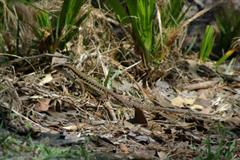Ameiva - Jungle
Middle American Ameiva, Central American Whip Tailed Lizard Scientific Name: Ameiva festiva
Sat, 16th November, 2024 - 10:40 am GMT
Sponsor Ads:

Alternative Name
Middle American Ameiva, Central American Whip Tailed Lizard Scientific Name: Ameiva festivaBasic Info
At maturity the Jungle Ameiva reaches between 25.4 and 30.5 centimeters (10 to 12 inches) in length. The Jungle Ameiva may be distinguished from some other popular ameivas by the presence of a single interparietal. Like most ameivas and whiptails, the Jungle Ameiva has a characteristic pointed snout with large rectangular scales on its belly.
Health
The Jungle Ameiva needs a humid environment that can range from high levels to moderate. Misting their enclosure every three to four days should create the proper environment, though frequency will be determined by the humidity of the ambient environment. Gradient temperatures are recommended. Daytime temperatures should be about 80 degrees Fahrenheit at the coolest end of the enclosure with a basking area about 90 degrees; while nighttime temperatures should be dropped to between 70 and 75 degrees Fahrenheit. Provide full spectrum lighting for about 12 hours per day.Habitat
Southern parts of MexicoBehavior
The Jungle Ameiva, is also known as the "Middle American Ameiva" and the "Central American Whip Tailed Lizard". This lizard should not be confused with the parthenogenic Whip Tail lizards in the genus Cnemidophorus. Most Jungle Ameivas are known to become quite docile with regular handling, though males may show aggression and can become quite territorial. For this reason, it is often suggested that males not be housed together. In the wild this ameiva lives in brushlands or woodlands. Like most ameivas, the Jungle Ameiva is somewhat hyperactive and can be difficult to hold. Their tails may also come off when they are handled, so it is essential that care be taken when they are picked up. In captivity they can be housed in a 40-gallon aquarium, though juveniles may be housed in a smaller enclosure. Make sure to include plenty of logs, plants, and branches for climbing, as well as dark hiding spots and shelters. In addition, a thick substrate is recommended because ameivas like to dig and burrow. Water bowls are also a must, for soaking and drinking. In captivity the Jungle Ameiva does quite well on a varied diet that may include waxworms, mealworms, earthworms, crickets, and pinky mice. Though they are carnivorous, they have been known to eat a piece of fruit occasionally.Origin
MexicoHistory
Jungle Ameivas are native to the Southern parts of Mexico.Common Foods
waxworms, mealworms, earthworms, crickets, and pinky miceSponsor Ads:
ideas that change business models and who can make money are the most threatening, outside actual religion. - John Day (Patterns in Network Architecture)
Ameiva - Jungle
Coded by: BGID® | ALL RIGHTS RESERVED Copyright © 2000-2024
Disclaimer | Privacy | Report Errors / Contact | Credits


 Beware the new Naval power, they are planning to come on stream with big naval might to match their ground forces. Chinese Aircraft Carrier - Chinese Navy
Beware the new Naval power, they are planning to come on stream with big naval might to match their ground forces. Chinese Aircraft Carrier - Chinese Navy  versus
versus 
 versus
versus  This Thread is about the North Korean Military itself - the kind of army, navy, and air force they have.
This Thread is about the North Korean Military itself - the kind of army, navy, and air force they have. 
 versus
versus  versus
versus 
 versus
versus  versus
versus